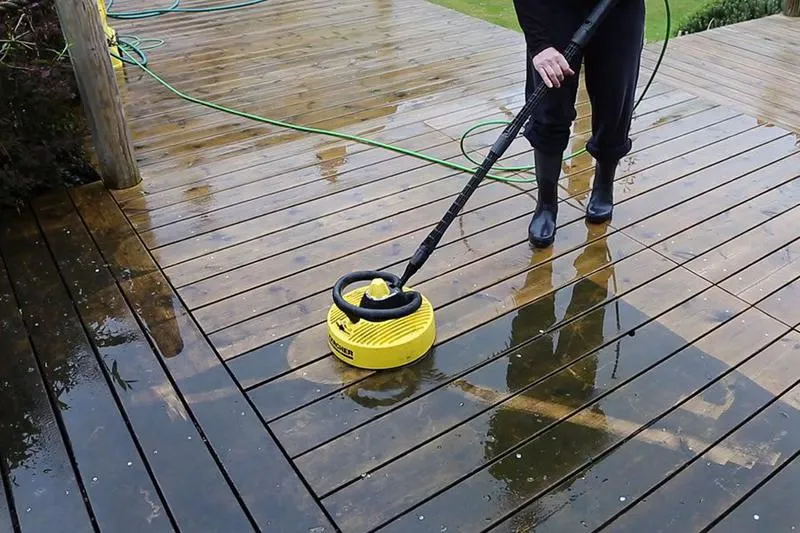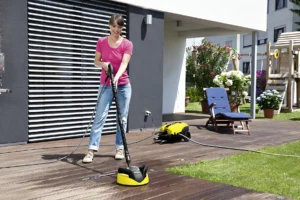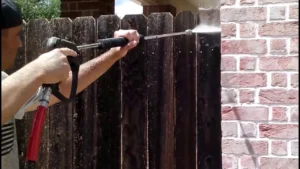A beautiful deck can transform your outdoor space, providing a perfect place for relaxation and entertainment. However, over time, dirt, grime, mold, and mildew can accumulate, making your deck look dull and unappealing. While many homeowners opt for a power washer to clean their decks, this method isn’t always ideal. High-pressure water can damage wood fibers, leading to splintering and premature aging. If you’re in Castroville, TX, and looking for an effective way to clean your deck without using a power washer, you’ve come to the right place.
Why Avoid a Power Washer?
Using a power washer might seem like an easy and effective way to clean a deck, but it comes with several risks. High-pressure water can damage wood, strip away protective finishes, and create long-term problems. Below are some key reasons why you should avoid using a power washer and opt for gentler cleaning methods instead.
Prevents Wood Damage
A power washer blasts water at high speeds, which can erode the wood’s surface and create splinters. This weakens the wood and makes it more susceptible to cracking and warping. Softwood decks, like pine and cedar, are especially vulnerable to damage. Even hardwoods can suffer from the intense force, leading to premature aging. Instead of preserving the deck, power washing may shorten its lifespan. Using a scrub brush and a gentle cleaning solution is a safer alternative to keep your deck looking fresh without harming the wood’s integrity.
Avoids Water Penetration
Power washers force water deep into the wood, causing it to absorb more moisture than necessary. This excess moisture can lead to swelling, warping, and even rotting over time. The deeper the water penetrates, the harder it is for the deck to dry completely, which increases the risk of mold and mildew growth. In humid climates, like Castroville, TX, where moisture levels can be high, using a power washer can make your deck more prone to damage. A simple garden hose with a spray nozzle provides enough pressure to clean without forcing excess water into the wood.
Preserves Sealant & Paint
Decks are often treated with a sealant, stain, or paint to protect them from weather conditions. Power washing can strip away these protective layers, leaving the wood exposed to the elements. This can lead to fading, cracking, and deterioration, requiring frequent refinishing. If you recently stained or sealed your deck, using a power washer can undo all that hard work in minutes. Instead, cleaning with mild soap and water ensures your deck stays clean without removing its protective coating. Regular sweeping and gentle washing help maintain the finish and prolong its durability.
Environmentally Friendly Alternative
A power washer uses a large amount of water, sometimes up to 4 gallons per minute, which leads to excessive water wastage. Additionally, if chemical cleaners are used, the high-pressure water can wash harmful substances into nearby soil, plants, and water sources. This pollution can negatively impact the environment and local wildlife. Cleaning your deck with a bucket, scrub brush, and biodegradable soap is a much more eco-friendly solution. This method minimizes water usage and prevents chemical runoff, making it safer for your garden, pets, and the environment.
Essential Tools & Materials
Cleaning a deck without a power washer requires some basic tools and cleaning solutions. Here’s what you’ll need:

Tools
- Stiff-bristle scrub brush
- Garden hose with a spray nozzle
- Bucket
- Broom
- Putty knife (for removing debris between boards)
Cleaning Solutions
- DIY Vinegar Solution: 1 part white vinegar + 1 part water (great for mold and mildew)
- Baking Soda Paste: Baking soda + a small amount of water (for tough stains)
- Mild Dish Soap Solution: ¼ cup of dish soap + 1 gallon of warm water
- Oxygen Bleach Solution: ½ cup of oxygen bleach + 1 gallon of water (for deep cleaning)
Step-by-Step Guide to Cleaning Your Deck
Cleaning your deck without a power washer is simple and effective when done correctly. By following a step-by-step approach, you can remove dirt, stains, and mildew while preserving the wood’s quality. Here’s how you can clean your deck thoroughly using safe and practical methods.
Clear the Deck
Start by removing all furniture, planters, and decorations from the deck to create a clean workspace. Sweep away loose debris like leaves, dirt, and dust using a broom. Pay special attention to corners where dirt tends to accumulate. Use a putty knife to scrape out debris stuck between the deck boards, as trapped dirt can promote mold growth. Ensuring a clutter-free surface will make the cleaning process more effective and prevent unnecessary staining or damage to the wood.
Rinse the Deck
Before applying any cleaning solution, rinse the deck with a garden hose fitted with a spray nozzle. This helps to remove surface dust and loosen up dirt. Avoid using excessive water pressure, as it can push moisture deep into the wood, leading to potential rotting. A gentle rinse prepares the wood to absorb the cleaning solution evenly. If the deck has stubborn dirt patches, a second rinse may be necessary to ensure all loose debris is removed before scrubbing.
Apply the Cleaning Solution
Depending on your deck’s condition, choose the appropriate cleaning solution. For general cleaning, mix dish soap with warm water. If your deck has mold or mildew, use a vinegar-water solution. For deep stains, an oxygen bleach solution works best. Apply the chosen cleaner generously across the deck using a mop or spray bottle. Let it sit for 10–15 minutes to break down dirt and grime. Avoid letting it dry completely before scrubbing to prevent streaks or uneven cleaning.
Scrub the Deck
Use a stiff-bristle scrub brush to scrub the deck thoroughly, following the direction of the wood grain. Scrubbing removes embedded dirt and stains without damaging the wood. Pay extra attention to high-traffic areas and spots with visible stains. For particularly tough stains, sprinkle baking soda over the affected areas before scrubbing. Continue scrubbing until the surface appears clean. This step requires some effort but ensures a deep clean without the need for high-pressure water.

Rinse Thoroughly
After scrubbing, rinse the deck completely with a garden hose to wash away all the cleaning solution and loosened dirt. Make sure to remove all soap residue, as leftover cleaner can leave streaks or attract more dirt over time. Rinse from one end of the deck to the other to ensure an even clean. If needed, do a second rinse to confirm that no suds remain. A clean rinse prevents buildup and keeps the deck looking fresh and natural.
Let the Deck Dry Completely
Allow the deck to dry naturally for at least 24 hours before placing furniture or walking on it. Proper drying prevents moisture from being trapped in the wood, reducing the risk of mold and mildew. If possible, clean your deck on a warm, dry day with minimal humidity to speed up the drying process. Avoid using the deck until it is fully dry to prevent footprints or dirt from sticking to the freshly cleaned surface.
Conclusion
Cleaning a deck without a power washer is entirely possible with the right tools and techniques. By using gentle, eco-friendly solutions and a little elbow grease, you can keep your deck in Castroville, TX, looking fresh and well-maintained without risking damage. Regular upkeep ensures longevity and enhances the beauty of your outdoor space. By following these simple steps, you’ll have a clean and inviting deck all year round—ready for backyard barbecues, morning coffees, and outdoor gatherings. Happy cleaning!





